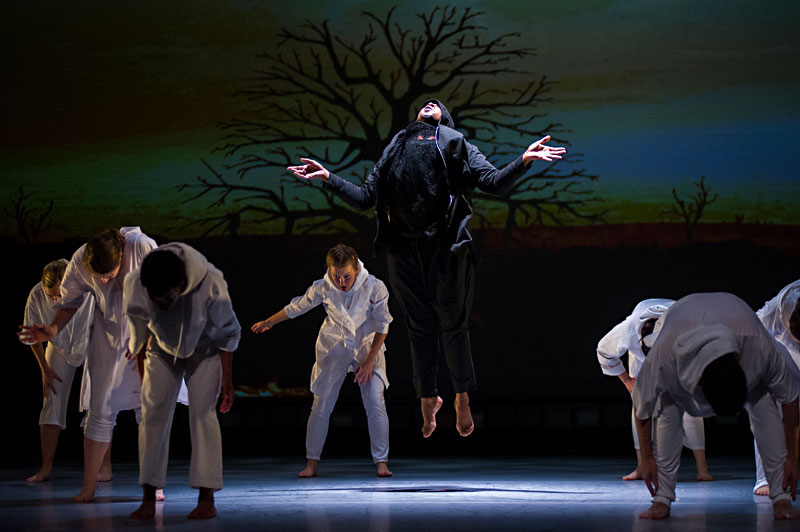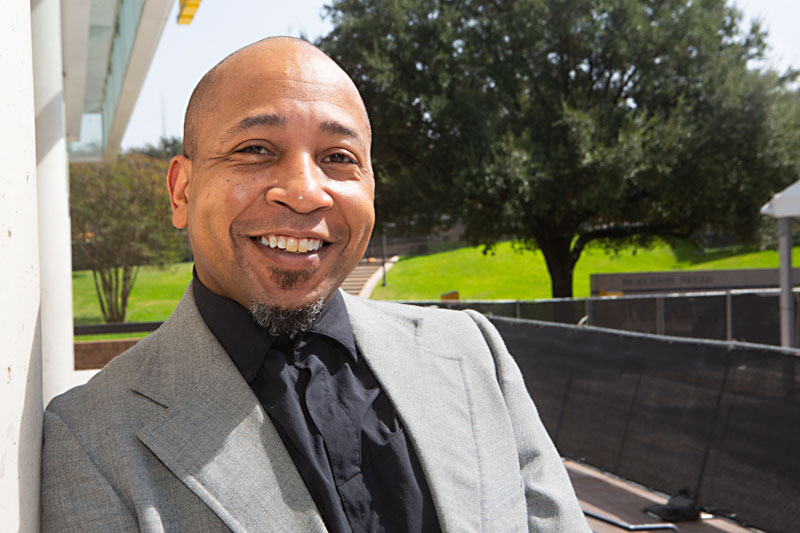For His Dance (Re)current Unrest, Charles O. Anderson Keeps Moving
Through the pandemic and other obstacles, the choreographer and UT teacher continues to adapt
By Robert Faires, Fri., Oct. 16, 2020
"Like so many of us, these pandemics – COVID-19 and ongoing systemic racism – have left me broke, broken, and tired ... yet still inspired nonetheless."
– Charles O. Anderson
"My 5-year plan is to make it through this year."
– Fuckology, shared by Anderson on Facebook
2020 has been seriously screwing with Charles O. Anderson. First, after years of developing and finishing a major dance project – about which Chronicle critic Jonelle Seitz wrote, "I don't think it's possible to overemphasize the importance of this work" – and planning to tour it nationally this autumn, along came the pandemic in the spring to make that impossible. Then, after a summer of scrambling to adapt the work from live performance to film so it could tour virtually and raising the funds to make that happen, he was just about to complete the film and stream it in the University of Texas Department of Theatre & Dance's 2020-21 season when one of his dancers tested positive for COVID-19.
"Trying to do this in the middle of a pandemic is not my best idea lol," Anderson wrote in his email letting me know.
Not the best idea, maybe, but without question the right idea. Because this is the right time for that work, (Re)current Unrest. Because 2020 has also been the year in which the murders of George Floyd, Breonna Taylor, Ahmaud Arbery, Tony McDade, Dion Johnson, Rayshard Brooks, Daniel Prude, and Jonathan Price, among scores of others, have driven the nation into the streets to protest the killing of Black Americans by police and to call for justice. And art that speaks to this racially charged moment, that addresses the social disturbance of this time and our awareness of the systemic oppression of Black people, is urgently needed.
So in the 16 years since March (another Fuckology quip Anderson shared on Facebook), the choreographer has kept pressing forward, always adapting when confronted with something that wasn't supposed to be this way.
The "Wasn't Supposed to Be"s
Now, 2020 wasn't the start of that. Anderson faced many previous "wasn't supposed to be"s.
(Re)current Unrest, for instance, wasn't supposed to be about systemic racism and violence against Black Americans. It was supposed to be about cultural appropriation. The furor over Beyoncé lifting movement by a white choreographer for one of her videos while the wholesale pillaging of Black culture by white people – take your pick: gospel, blues, jazz, soul, etc. – rarely provokes comment spurred Anderson to make a dance about white appropriation of Black culture and the erasure of Blackness when that occurs. He decided to do it through works by composer Steve Reich that used voices of Black men but distorted and looped them so they were bled of their character and context – such as a man describing the aftermath of his beating by police. That became (Re)current Unrest, which Anderson presented a first draft of in a program at the UT Department of Theatre and Dance.
Then a student was murdered. Haruka Weiser was a month from finishing her freshman year when she was killed while walking back to her dorm after a rehearsal. The entire department was shaken, but Anderson was hit especially hard. Haruka was one of his students. And that changed (Re)current Unrest. "Between that tragedy (committed by a young African American man) and the ongoing systematic killing of black men by law enforcement in this country, the piece took on larger dimensions," he wrote. "I really started paying attention and going deeply into research on the Black Lives Matter movement and its parallels with the Black Power and Black Arts movements of the 1960s and '70s." Over the next two years, Anderson pursued this new direction for (Re)current Unrest at UT.
And Anderson wasn't supposed to be in Texas. His life had been spent on the East Coast, and he'd built a strong home base in Philadelphia. He'd earned his master's at Temple University. He'd founded his own company, the Afro-contemporary dance theatre X. He'd come to national attention, winning early career honors: a $60,000 Pew fellowship in the arts, being included on Dance Magazine's "25 to Watch" list, being named one of "12 Rising Stars in the Academy" by Diverse magazine. In nearby Allentown, at Muhlenberg College, he'd secured his place in academia – as a teacher of dance, naturally, but also as a scholar in African American studies, creating the school's first program in that field. Philly was where he had it going on.
And then Lyn C. Wiltshire came calling. A choreographer and longtime faculty member at UT, she headed the dance division in 2010 and felt it was time – no doubt long past time for a program founded in 1945 – to bring Black dance into the curriculum. She worked to create a position for the right person to teach it, and that person was Anderson. So in 2011, he left the East Coast for the Third Coast, arriving in Austin on his 40th birthday to join UT as associate professor of African American and African diasporic dance. Now, nine years later, Anderson is heading the dance area himself – a sign that he's found some reason to keep teaching dance and making it here.
That he's teaching and making dance anywhere is notable, though, for in the grandfather of all his "wasn't supposed to be"s, Anderson wasn't supposed to be in dance. He enrolled in Cornell University to major in mechanical engineering. But seeing dance changed his mind – well, that and having his roommate's girlfriend, who caught his moves at a party, persuade him to come to a dance class. From that, he realized dance was what he wanted to do, and maybe what he'd always wanted to do. It had been in his life all along, at parties and in clubs but also in the movement-filled testifying of his Baptist church congregation. As he told one interviewer, "My spirit learned to dance before my body."
Right away, he started choreographing – solos that allowed him to speak through his body – and his first piece earned him a full scholarship to the American Dance Festival. That opened a new world of movement to him, beyond classical ballet and Merce Cunningham, so he attended its summer intensives for three years. After college, he moved to New York and studied with African American choreographer Ronald K. Brown, then danced with his company Evidence while holding down a day job teaching chemistry and physics at a school in East Harlem. In time, Anderson made the move to Philadelphia – at the time a supportive town for emerging choreographers – and then eventually to Texas and UT and now to (Re)current Unrest.
Keep Moving
Tracing that project to its source reveals an odd couple of musical deities: Reich and Beyoncé.
With the famed minimalist, the connection stretches all the way back to Anderson's undergraduate years. Reich also attended Cornell – class of '57 – and, Anderson says, was revered there as "a god." But Anderson himself had a "complicated" relationship with Reich's music. "It was both familiar and strange to me," he told Fusebox Festival Associate Artistic Director Anna Gallager-Ross before presenting (Re)current Unrest at the 2018 festival. "So I knew that at some point I wanted to work with his music."
The pop goddess came into the mix when Beyoncé was royally roasted for including some choreography by Belgian dancemaker Anne Teresa de Keersmaeker in her 2011 video for "Countdown." The incensed internet condemned it as "ripping off" and "theft," and de Keersmaeker called it "plagiarism" and "stealing" even though Beyoncé openly acknowledged the appropriation. Anderson recognized a familiar racial double standard at play there: When a Black artist incorporates the work of a white artist, it's piracy, thieving; when a white artist incorporates the work of a Black artist, it's borrowing, referencing, homage. The former inspires outrage, the latter applause. So it was when white composer Reich used West African rhythms and percussion in his music: It helped make his career. And his incorporation of voices of Black men in his first major works – the mid-Sixties compositions "It's Gonna Rain" and "Come Out" – seems not to have occasioned any controversy then, or in 1982, when de Keersmaeker made "Come Out" the score to one section of her dance Fase.
Thus, issues of cultural appropriation and authorship led Anderson to finally work with Reich's music. At least, that was the idea when 2016 started. But April saw the tragic murder of Haruka Weiser, and July the murders of Alton Sterling and Philando Castile by police. Taken with the police killings of Eric Garner, Michael Brown, Tamir Rice, and Walter Scott in the previous two years and the rise of the Black Lives Matter movement, Anderson felt compelled to expand his work's scope.
Over the next two years, (Re)current Unrest evolved into a work of profound power. In it, Anderson created a space in which time was fluid, one moment in our day, another in the Sixties when the war for civil rights was waged, another in a time – earlier? later? – when lynching was the deadly fate of many, many Black people, Anderson's great-grandfather among them. The audience could be present at any point of American history and witness again and again and again the oppression of Black people and their pain and sorrow and resistance.
All was fluid here. A large ensemble of dancers dressed in hoodies and loose clothes, either all black or all white, moved as a community, though their actions might be inspirational one instant and threatening the next; innocuous white hoods, pulled up, chillingly evoked the Klan. Ecstatic dancing gave way to writhing, clapping to screaming. Laughter, rising in volume and intensity, morphed into hysteria. Hands lifted heavenward in praise became gestures not to shoot. A rope holding a swing transformed into a noose. Everything was in a constant state of unease, disturbance, disruption, agitation, which Anderson relates to "staying woke," retaining awareness of community issues and social justice.
The work's impact was magnified by its visuals and sound: projections of rain streaming down: a bleeding American flag; a tree with the words "equality," "liberty," and "justice" hanging from its limbs like bodies; recordings of the spiritual "Another Man Done Gone," Terence Trent D'Arby's "As Yet Untitled," Not in Our Name's "Pledge of Resistance." But essential to (Re)current Unrest's power were the dancers who formed the ensemble. Almost exclusively students in Anderson's department, they committed themselves wholly to both his choreography and the spiritual and emotional trauma underlying it. No matter who they were, no matter their color or culture, they absorbed the history of pain in the work. And as Seitz noted after the Fusebox production, "The dancers' embodiment of these histories of neglect, whitewashing, white power, Jim Crow, racial profiling, discrimination, and brutality – as well as the social movements that rose to look these demons in the eye – is significant." It signals the students' belief in what Anderson is saying and in Anderson himself.

The Griot
To them, Anderson is more than a choreographer, an instructor, a department head. He guides them, he passes traditions on to them, he challenges them, he gives them space to collaborate and create, he holds them together. A month before mounting (Re)current Unrest at Fusebox, Anderson presented another work in the spring dance program at UT. Titled Idòbálè – referring to the Yorùbán concept of "showing respect upon greeting and leaving" – it was created for the third anniversary of Haruka Weiser's death, in the year she would have graduated. As Anderson wrote then, it was his "humble attempt to offer her a ceremony to mark that occasion," and in his humility, he did not make this work alone. Anderson drew on the entire ensemble for help, and while his choreographic hand was much in evidence, the dance felt like a communal effort, a public mourning and remembrance of one of their own. That was perhaps the most visible Anderson touch of all.
In (Re)current Unrest, Anderson also was a colleague, dancing among the students as a griot figure, a keeper and sharer of histories. In performance, he wore four centuries of struggle in his face and body, his expression agonized, stressed. He would kneel, one hand raised, at times open but always closing in a fist, as his other closed hand beat his chest over his heart. And always he rose again, dancing intently, defiantly. Seitz noted that he appeared to be "the concertmaster for the ensemble, at times leading them and other times seeming to express dismay at their inattention to him." In one moment, he removed a noose from the neck of a young Black dancer and placed it around his own. If those actions also sound like those of a parent ... well, Anderson has been called "Dance Dad."
He consciously relates to the role. "Since moving down to Austin, I've been very interested in the millennial generation of dancers – the early twentysomethings are a whole other breed of human beings to me," he told Gallagher-Ross. "So I made the choice to cast almost exclusively dancers under 25, and because of my relationship to UT, 60% are UT dance alumni. I don't have kids, so in a lot of ways this work is the letter to my legacy, or to the folks I'm never going to have, biologically speaking, so that's on my mind a lot. I ask myself on a regular basis: What is my legacy if I don't have my own kids?"
Anderson may wonder, but others have found their answer: in his work with his students, in his scholarship in African American Studies and African-derived movement, in his creativity as an artist, in his holding of history, in his kinetic storytelling, in his truth-telling, in his testifying, and, yes, in his ability to adapt whenever something isn't supposed to be that way. They see it, and they're honoring it now. The year may have upended one plan of Anderson's after another, but 2020 is also the year when 315 supporters and friends of his donated more than $15,000 for his film of (Re)current Unrest, when he received the UT Regents Outstanding Teaching Award, when he won the University Co-operative Society's Creative Research Award, and when he was chosen as one of the inaugural artists for the Texas Performing Arts/Fusebox Festival residency program supporting local performing artists in developing new work.
And despite the pandemic, (Re)current Unrest will go on. The student who tested positive received a clean bill of health, rehearsals resumed, and the streaming was rescheduled. So whether or not Anderson believes this is his "best idea lol," it's happening. He's making it happen. Because when there are truths to tell, Charles O. Anderson always keeps moving.
Charles O. Anderson’s (Re)current Unrest will be livestreamed Oct. 16-17, 7:30pm. For more info, visit www.jointhedrama.org.












